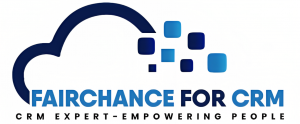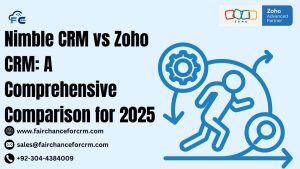The topic we covered today is all about Why Should Businesses Switch from Excel to CRM? In the early phases of a business, controlling customer data with Excel spreadsheets might seem sufficient. They offer an acquainted and easy way to track relationships and store information. However, as businesses grow and their customer base grows, the constraints of Excel become more obvious. From handling complex data to keeping real-time revisions, Excel can quickly become complicated and prone to errors.
Enter Customer Relationship Management (CRM) systems powerful tools designed to simplifies and enhance customer interactions and business activities. Unlike Excel, CRMs offer moved features such as controlled data entry, integrated conversation channels, and stated analytics that offer valuable insights into client behavior and business achievement. These features not only save time but also foster better decision-making and stronger customer relationships.
In this blog, we’ll examine the reasons why moving from Excel to a CRM is critical for expanding companies. We’ll also see why using Excel only offers a subset of the features that CRM offers, such as improved data accuracy, scalable solutions that can grow with your company, and increased efficiency. Complete information related to Businesses Switch from Excel to CRM is discussed below.
Also Read:
- How To Do Zoho CRM Integration with RingCentral?
- Zoho Deluge and Attachments: Adding and Managing Attachment URLs for Contacts
- Zoho CRM Customize Task Reminder
- Zoho CRM Transferring Linked Attachments To Another Module
- Zoho CRM How To Delete Lead With Deluge
What is it Like to Manage Business Work in Excel and Why Businesses Switch from Excel to CRM?
These features not only save time but also foster better decision-making and stronger customer relationships. In this blog, we’ll examine the reasons why moving from Excel to a CRM is critical for expanding companies.
We’ll also see why using Excel only offers a subset of the features that CRM offers, such as improved data accuracy, scalable solutions that can grow with your company, and increased efficiency.
Challenges Faced by Businesses Using Excel
Scalability Issues: As data volume grows, Excel sheets can become unbearable and slow. Large data sets may cause achievement issues, and controlling complex data in multiple interconnected bedding can lead to errors and inconsistencies.
Version Control: Keeping track of changes made by numerous users can be challenging. Without a controlled version control system, corporations may battle with conflicting data entries and dated information. Data Integrity
Risks: Manual data entry and equation errors can hinder data accuracy. Businesses may face difficulties ensuring data integrity, especially when dealing with complex calculations or large datasets.
Security Concerns: Excel lacks developed security features found in dedicated data management systems. Sensitive data may be at risk if not adequately safeguarded, as Excel files can be easily discussed or accessed by unauthorized individuals.
Limited Integration: While Excel integrates with other the company Office uses, it may not seamlessly connect with specialize business systems such as Customer Relationship Organizations (CRM) or Enterprise Resource Planning (ERP) software. This limitation can limit the efficiency of data flow across different business operates.
7 Reasons to Businesses Switch from Excel to CRM
Switching from Excel to a CRM system offers effective advantages that can transform how you manage your business operations.
Here are the reasons why making the switch is a smart move for your business:
Improved Inter-Team Communication
Your staff can access your data systematically, thanks to a CRM. As a result, there are fewer misunderstandings and more successful cooperation and interaction because everyone is operating from the same set of facts.
Grow Your Company Easily
Managing data and processes in Excel can become overwhelming as your organization expands. CRMs have been designed to scale your organization, handling rising volumes of data and complex workflows effortlessly, making expansion easier and more controllable.
Increase Productivity with Automation
Automation is one of the main advantages of CRM systems. CRMs automate workflows and processes, in contrast to Excel, which requires repetitive chores and individuals data entry. This implies a decline in errors, a decrease in manual labor, and an increase in collaboration on strategic goals.
Acquire Real-Time Knowledge to Make Better Decisions
Excel just cannot match the real-time data and comprehensive analytics that CRMs offer. Instant access to current information enables you to take educated choices more quickly, making your company adaptable and open to changes in the market.
Use Personalized Actions for Building Customer Relationships
CRMs let you keep track of client preferences and interactions, which helps you personalize your communications. Better client interactions and connections follow, which eventually increase corporate results.
Assure Compliant and Security of Data
Data security is vital, and while Excel lacks advanced security features and compliance oversight, CRM solutions have. Strong security mechanisms in a CRM make it easy to protect critical data and comply with laws.
Use Linked Technologies to Enhance the effectiveness of Your Processes
CRMs connect with a range of platforms and technologies, which streamlines your operations and does away with the need for manual data transfer. The general effectiveness and error reduction offered by this integration will enhance the coherence and fluidity of your activities.
Replacing Excel with CRM is an investment in a technology that will assist with the growth and achievement of your company while improving effectiveness, safety, and collaboration.
How To Migrate from Excel to CRM and Businesses Switch from Excel to CRM?
Your company’s operations can be significantly enhanced by switching from Excel to a CRM system, which offers sophisticated capabilities and streamlines procedures.
This is a step-by-step guide to help you make a seamless and successful transition:
Examine your data
Reduce complexity and migration costs by thoroughly evaluating your existing data. Examine if importing obsolete contact email templates from previous branding initiatives is required.
Analyzing your data and selecting what to keep or discard will help you get started on your data migration checklist. If you decide to save some data, clean it up, but make sure you always backup your data prior to making any changes to prevent problems later.
Data Purification
Spend some time becoming familiar with your new CRM system before moving further with the data transfer. Every CRM has different procedures for importing and organizing data.
For example, existing customers and leads may need to be stored in different areas of the CRM. Be prepared for differences from your previous CRM and adjust the import process to fit the new system’s requirements.
Mapping within the Field
Proceed with mapping data when you have decided where your data will be kept. Fields from your old dataset must line up with those in the new CRM in this stage. This enables reliable data transfer and prevents the destruction of custom fields.
Migration of Tests
Perform a test migration using a tiny dataset before exporting all of your data. Check the test data carefully for problems by importing it into the new CRM. With this trial run, you may find possible problems early and fix them before the full migration. If issues occur, work through the issues and try over until the process runs smoothly and successfully.
Get Expert Assistance
You could believe that moving data from Excel to CRM is an exhausting and time-consuming endeavor.
We have more than eight years of expertise meeting our clients’ business requirements with online-based ERP, cloud CRM, and e-commerce business automation solutions.
Several of the Top Salesforce CRMs for 2024:
Leading the CRM space, Salesforce is still doing well globally. It has several features to suit any CRM requirements. Salesforce is now used by hundreds of thousands of small and large businesses to manage their operations. Reach out to Fairchance for CRM if you’d like assistance in beginning with Salesforce. As a Certified Salesforce Partner, we have years of experience working with companies just like yours.
Zoho CRM:
While Zoho offers a full range of SaaS company offerings, its CRM is one of the best solutions available. Zoho
CRM from HubSpot:
HubSpot CRM is known for its robust features and easy-to-use interface. For managing contacts, sales pipelines, and marketing initiatives, it offers a smooth experience. For companies of all sizes, HubSpot CRM’s free plan is a great place to start, with the opportunity to pay for extra features as your needs change.
New sales:
An easy-to-use CRM platform with robust automation capabilities and insights fuelled by AI is provided by Fresh Sales. It is intended to improve efficiency, simplify your sales procedures, and offer useful data that will spur growth. Fresh-sales is known for its user-friendliness and potent lead management features.
Microsoft Dynamics
CRM and ERP features combine in Microsoft Dynamics 365 to offer a complete solution for managing customer interactions and corporate operations. Its close connection with other Microsoft goods and flexibility make it
Pipedrive:
With its intuitive UI and transparent sales pipeline, Pipe drive was created with sales teams in mind. Teams may more easily manage their transactions and track their progress because to their simplicity and efficacy. For small to medium-sized businesses looking for an easy-to-use and effective CRM solution, Pipe drive is the best choice.
For more information about the Zoho CRM Customize Task Reminder, visit this link.
If you want to Free Trail Zoho, click on this link.




